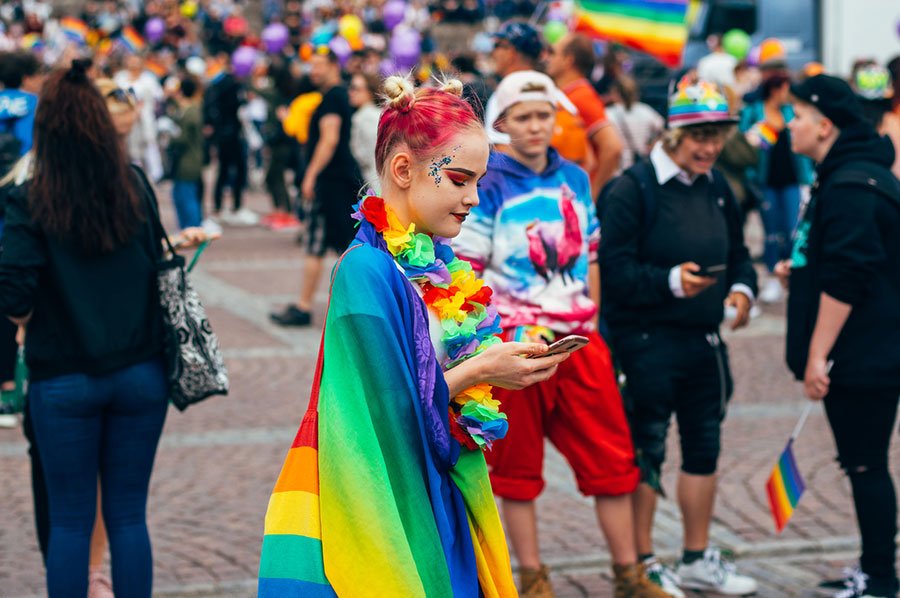LGBTQIA+ pride is something that many of us anticipate all year long. Some of us plot the perfect outfit, while others spend hours on the elliptical, shedding a few pounds of winter fluff. As we ready ourselves for a season of celebrating, we may forget to prepare for one thing: our families.
Although many families may celebrate Pride season, it can be a major trigger for other families, especially religious ones.
Religious parents of LGBTQIA+ children may have preconceived notions of both Pride and LGBTQIA+ people. Stigmas surrounded the gay community of the 1970s, 80s, and beyond, leaving parents with associations and definitions of LGBTQIA+ folks that are not only inaccurate, but also negative.
Not so long ago, Anita Bryant embarked on a national anti-gay tirade, and preachers claimed that the AIDS epidemic was God’s judgment. Meanwhile, religious communities saw LGBTQIA+ people as only another symptom of the ‘sexual revolution’ that had swept Western society at large..
Whatever the context, parents need to learn who the LGBTQIA+ community is today. They may need an update on how they understand and categorize who we, the LGBTQIA+ community, are.
As Pride season ends, both families and children may feel frustrated, hurt and confused. Perhaps parents have seen photos on Instagram or wonder about the intent of Facebook posts that might appear to be passive aggressive or flat out angry.

In my practice, I have often seen that parents hold secret discussions about their child’s online or in-person behavior during Pride. So, here are two tips to help you proactively address family dilemmas this Pride season:
1. Avoid the Resentment Petri Dish
Talking with children about sexual orientation, a life with a same-gender partner, or dating can be very challenging for many parents, especially those with strong religious convictions. The discomfort in broaching these topics can complicate and sometimes even poison a relationship. Like a petri dish where bacteria thrive, silence can be the perfect environment for resentment to grow and intensify.
I know this all too well as a child of two pastors. The longstanding silence between my parents and me didn’t help us stay close. In fact, it did nothing more than stabilize our preconceived biases about each other, and it forced us to live in separate corners of the relational playing field. We were only able to connect, however, once we dared to bring up our assumptions, our confusion and our pain.
I began to realize that my parents were far more loving than I had given them credit. And I believe they saw who I really am, rather than who they speculated me to be.
Whether you’re the parent of an LGBTQIA+ child or an adult child of a religious parent, ask questions about your loved one. Parents can ask about their child’s self-discovery as a sexual or gender minority, the struggle of living closeted, and how their child finds strength—and even confidence—in who they have become. Children of religious parents can ask about what they learned of the queer community as they grew up and how they can introduce their family to future romantic partners.
Of course, one caveat is that not every parent or child has the maturity and respect to hold a safe conversation. But should your family member prove to be trustworthy, take the bold step to break the silence. Focus on topics that will re-establish connectedness rather than lead to debate or the need to be “right.”

2. Become Familiar with the Language
For many parents, the language of the LGBTQIA+ community can seem daunting and may help reinforce the ideological distance that keeps parent and child at arm’s length. Many parents who have participated in my clinic have avoided learning the terms that distinguish sexual orientation, gender identities, relational orientations and cultural dynamics because they fear saying something incorrect or offending their child.
Luckily, there are many resources for parents, like this one from the Human Rights Campaign website.
By showing your willingness to learn and invest time in understanding your child, you will signal openness and safety, which your LGBTQIA+ child will welcome with open arms.
Pride season could light a major fuse or it could be a spark that leads to greater connection. Talk openly about how you feel in a safe manner. Take time to learn about one another’s experiences—key moments that shaped your understandings of the queer community—and offer one another grace as all parties involved grow alongside one another. Learn about parent support groups here!
Family work may not be easy, but plenty of resources, therapists and support systems can help. You may not resolve every tension or concern, but focusing on connectedness can leave your family more united and peaceful.. Whether or not parents and children agree, they can still live happily connected.
Find a family therapist. Contact us for a free consultation.


